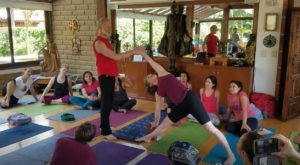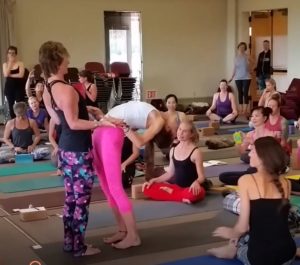Tips for filming an Anusara Yoga Video

Anusara is … Effectively demonstrating precision in teaching
Filming a video to demonstrate your understanding of Anusara Yoga
is an important and demanding process. The guidelines below are written to help
in your refinement and presentation of your class for evaluation.
Opening
. • Position the camera in front so as to face the class; one camera is sufficient.
. • Guide the students to be sensitive to the Om and invocation, experience the softening – in ears and voice.
Theme
. • Personalize the aspect of theming with a story and make a point relative to the theme.
. • Avoid being too ‘lofty;’ apply theme to concrete situations, include emotions/feelings
. • The theme is a general/universal idea and needs to be brought into context.
. • It can be a story or good quote that expresses the idea of the theme.
. • Utilize the concept of having a “star and a co-star” themes; one dominates and the other supports.
. – “In order to fully become our authentic self we need to draw on a deep steadfastness, a deep presence and inner calmness. In order to express Ananda we have to have this deep feeling of steadfastness to move from.”
Personalize your Theme
. • Reference something from your own experience that is relative and relevant, without being too heavy bringing people down or being too detailed.
. • Bring it down from the lofty to how it applies to us, in big and small ways:
. – “We all have situations that challenge us and ask us to pull deeply into this place from which we unfold.”
. • Throughout the class reference why you chose the personal story or theme and personal story and how it is relevant:
. – “While you come into this pose you may challenge you in a way that you find it uncomfortable so you pull into this theme/story of….(steadfastness, stability….).
Heart Quality
. • Heart quality should be a clearly “feeling” word or phrase:
. – When you are open and sensitive how do you feel? Vulnerable? Calm? Peaceful?
. – Hug to the midline and feel secure.
. • Prepare a list of synonyms for it.
. • Use the physical alignments to show how they fully integrate with the heart qualities.
Alignment Focus
. • Have a ‘primary’ alignment action (likely with a refinement included) and a secondary or complimentary one.
Language
. • Use feeling words describing action:
. – Step forward and feel secure.
. – Plant the foot solidly.
. – Settle into the sit bones with equanimity.
. – Vibrantly hug to the midline.
. • Be succinct and add space/pause
. – Pull from your feet to the pelvis.
. – From the center of the pelvis press through the core lines of the legs.
. • Vary the pace and volume
. • Leave quiet space
. • Do not talk too much
Warm-Ups
. • Come to kneeling or standing up soon after the Invocation
. • First five minutes back off of theme and just guide students into movement without holding the poses for a very long time; few alignment instructions at first with more prompts to make bigger movements with the breath.
. • Use only one or two references to theme and alignment.
. • Poses should be “easy to perform, dynamic and not held very long”
Touching deeper on a concept.
. • Embed the instruction into a pose without pausing; don’t stop the class and have them stand or sit without feeling it expressed/manifested in a pose. Use the body alignment to express the concept or idea. Why are we talking about this lofty idea in a yoga class? What we are doing with the body should embody your thoughts.
. • When asking a question such as “how does this feel, right now in this pose” interweave the theme, pause and be succinct in answering the question …. “It is solid.”
Using Props
. • As students work up the heat and intensity that is when weaving in the heart quality is most effective; when the energy picks up the emotion can be stronger and the theme can be more engaging. Don’t back off, match fire with fire and see how the physical intensity can be translated into an emotional feeling: “When faced with the physical challenge pull into what supports you.”
. • Avoid use of props unless you know of a specific student’s need for one.
Teaching the 5 UPAs
. • Go through all 5 in order once or twice
. • Put in early
. • Be extremely brief with the alignment principles that are not the primary focus; no more than 4 – 5 words.
. – Example in Warrior II: “Expand with the breath; hug in to the midline until you feel the solid place that supports you; thighs back; scoop the tailbone down and shine out!”
. • Focus on one main UPA emphasized throughout the class and fully cover all actions involved sequentially; add a feeling heart quality to the emphasized alignment to bring connect it to the deeper purpose of practicing yoga.
. • Mention pulling into the Focal Point from all sides (not just the legs!)
. – “Pull in from the feet up to the Pelvic Focal Point, from the head down, all parts connected and participating equally.”
. • If using two UPAs, focus on one and use the other more selectively or partial: keep it simple and easy to grasp.
Prepare key prompts for specific poses
. • Become familiar with a set of brief instructions for aligning into each pose
. • Use a written guide and post off to the side should you need a prompt during class
. • Weave in examples using theme
. • Staccato voice, i.e. Be brief and precise

Anusara is … Expanding Shri, the vibrancy of life
Demo
. • Make the demo relevant to the key alignment point your are focusing on. A demo can be used to clarify an alignment point that portion of the class is showing that they don’t understand. The demo doesn’t have to be the apex pose.
. • Weave in the feeling quality of the theme Be succinct using short action statements: “Hug to the midline”
. • Do the demo twice/both sides so the students can digest it
. • Make the demo clearly and dramatically to demo the action.
. • In fullness of the pose (while demoing the second side) use a short “symbol crashing” chit/ananda statement that crystallizes how it is part of the theme:
. – “Pulling into this pose I face the challenge so that I can shine out.”
. – “Creating this stability is directly related to being stable during challenging times off the mat, as well as on.”
. • Clearly show the actions you want the students to do: describe what you are doing:
. – “Soften and pull inward; settle; hug into your inner core. First I’m going to pull in hugging to the midline; then, from here I’m lifting from my solid base; I’m ‘shining out!”
Avoid sitting while teaching
. • There may be times you will want to illustrate the seated pose to show an alignment; do so briefly but do not stay seated. Sitting diminishes the energy.
. • Briefly show the action then stand back up, no more than 10 seconds
Physical Adjustments
. • Twists are good for demonstrating hands-on adjustments: help a student twist by placing your hands around their ribs and assist in their roll.
. • Enhance student’s beauty and deepen the pose: “feel-good adjustments.”
. • You can combine verbal with physical adjustment both at the same time:
Eagle-eye view
. • Look and see with your “x-ray eyes” what the students are doing and offer succinct instructions to guide them into greater alignment. See how doing this will grant you the opportunity to expand on the spiritual aspect, as well as improve the physical expression of the pose.
Cool downs
. • Forward bends and twists after backbends emphasize the actions of reconnecting thigh bones to hamstrings. (This is a logical, solid integration with the theme/alignment focus of ME.)
. • Class should be at least an hour and fifteen minutes; start to wind down after the peek/focus pose (approximately one hour into class), then begin the cool-downs and move into meditation and/or savasana.
Submit an outline
. • Write out 5–6 sentences showing where you make the story felt and personal, how you make it feel concrete and tied it into the pose. Show how you integrate the heart quality with the instruction:
. – “In this pose is where I am going to drive home the point of how the action is related to my story.”
. – “This is the feeling that sustains you when you are dealing with the challenges of life.”
Turn in the entire class sequence when submitting the evaluation.
. • When working with a mentor’s guidance write out the entire class sequence to show the evolution towards the peak pose and how your theme supports the sequence.
Key Evaluation Points:
. • Safety
. • Support
. • Love and concern for the students
. • Have a well-crafted Theme and weave it into your instructions
. • Heart Quality
. – Express the reason the theme and heart quality are important
. – Encourage an Inside-Out expression of the Heart Quality
. – Interweave theme and Heart Quality throughout class
. • UPA focus on just one or two alignments
. • Chit/Ananda grand purpose of yoga
. • Sitting and Centering – less than 7 minutes
. • Introduce the Theme and Heart Qualities in the warm-ups
. • Use/demo all 5 UPAs in one pose
. • Active/Passive Language
. • Instruct based on observation
. • Setting the Foundation
. • Working with misalignments:
. – verbal, then manual adjustments
. – suggest props when needed
. • Demo:
. – 1-2 key points only
. – Vocalize how using alignment
. – Show how theme and heart quality are relevant
. • Slow the class down after the peak pose and let the students cool down and integrate the theme and alignment that was focused on; keep them relevant here as well.
. • Conclude with a meditation and/or savasana





